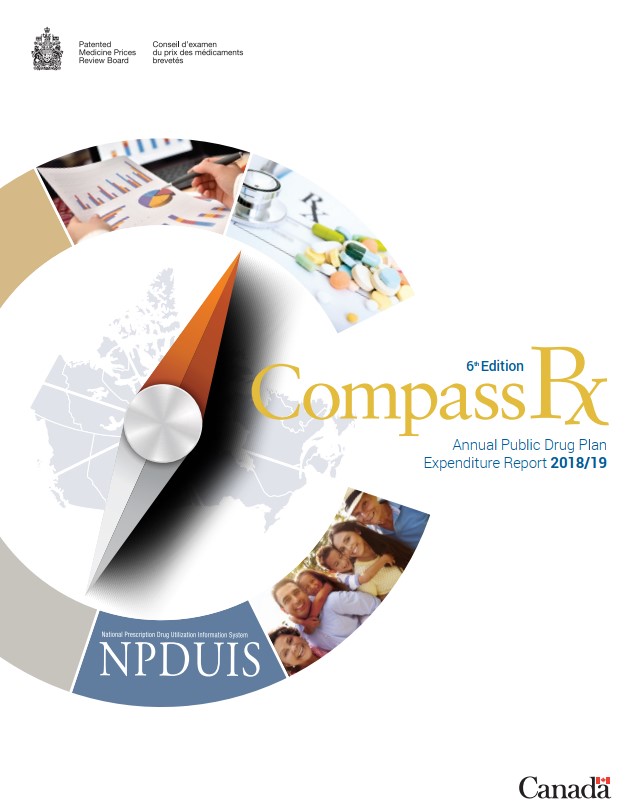CompassRx, 6th Edition
Executive Summary
Prescription drug expenditures for the NPDUIS public drug plans increased by 5.6% in 2018/19 to reach $12.1 billion, driven primarily by a marked increase in the use of higher-cost drugs and the introduction of Ontario’s OHIP+ program.
The PMPRB’s CompassRx report monitors and analyzes the cost pressures driving changes in prescription drug expenditures in Canadian public drug plans. This sixth edition of CompassRx provides insight into the factors driving growth in drug and dispensing costs in 2018/19, as well as a retrospective review of recent trends in public drug plan costs and utilization.
The main data source for this report is the National Prescription Drug Utilization Information System (NPDUIS) Database at the Canadian Institute for Health Information (CIHI), which includes data for the following jurisdictions: British Columbia, Alberta, Saskatchewan, Manitoba, Ontario, New Brunswick, Nova Scotia, Prince Edward Island, Newfoundland and Labrador, Yukon, and the Non-Insured Health Benefits Program.
The findings from this report will inform policy discussions and aid decision makers in anticipating and responding to evolving cost pressures.
Key findings
Prescription drug expenditures for the NPDUIS public drug plans increased by 5.6% in 2018/19, bringing annual spending to more than $12 billion.
- Between 2013/14 and 2018/19, the total prescription drug expenditures for Canada’s public drug plans rose by $3 billion, for a compound annual growth rate of 5.5%.
- Drug costs, which represent 80% of prescription drug expenditures, grew by 5.8% from 2017/18 to 2018/19, while dispensing costs, which account for the remaining 20% of expenditures, grew by 5.1%.
- The NPDUIS public drug plans paid an average of 87% of the total prescription costs for 292 million prescriptions dispensed to almost 8 million active beneficiaries in 2018/19.
- The OHIP+ program accounted for a 7.6% increase in total prescription drug expenditures for Ontario in 2018/19 and a 4.4% push on spending for all NPDUIS public drug plans.
Drug cost growth for the NPDUIS public plans in 2018/19 was primarily driven by a greater use of higher-cost drugs as well as the introduction of the OHIP+ program in Ontario, and was offset in part by savings from generic price reduction and substitution.
- The increased use of higher-cost drugs continues to be the most pronounced driver, pushing costs upward by 6.7% in 2018/19, despite more modest impacts from the use of DAA drugs for hepatitis C.
- More than half of the total drug costs in 2018/19 can be attributed to less than 5% of public drug plan beneficiaries. High-cost drugs, which were used by less than 2% of beneficiaries, accounted for over one third of costs.
- The overall increase in costs was also heavily influenced by Ontario’s universal coverage program for youth aged 24 and under. Without OHIP+, the 5.8% total drug cost growth in all NPDUIS public drug plans would have been reduced to 1.1%.
- In 2018/19, generic pricing policies and substitution had a notable -6.2% effect on costs, due in large part to recent policies reducing the maximum price of many top-selling generics to 10%–18% of the originator price.
- Other factors, including the volume of drugs and the size of the beneficiary population, had a relatively small influence on the growth in drug costs for public plans.
Dispensing costs in the NPDUIS public plans reached $2.4 billion in 2018/19, marking notable growth over the previous year, largely as a result of Ontario’s OHIP+ program.
- The overall growth in dispensing costs was 5.1% (or $117.4 million) in 2018/19, a steeper increase than that observed in the previous three years, though results varied among individual plans.
- The OHIP+ program had a significant impact on the growth in dispensing costs, pushing costs upward by 3.5% ($80.5 million) nationally and by 6.3% in Ontario.
- Apart from changes due to OHIP+, an increase in the number of active beneficiaries had the greatest impact on the dispensing costs in 2018/19, pushing overall costs up by 2.0%.
- The decrease in the volume of units dispensed to patients and a decline in the overall average dispensing fee per prescription pulled dispensing costs down by nearly 1%.
